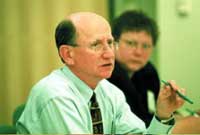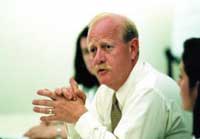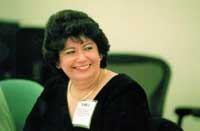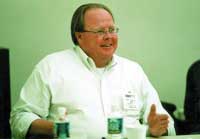Advisory Board Explores Procurement Promises and Pitfalls
 |
|
2003 Editorial Advisory Board Bruce Hartmetz, CPPB Buyer, City of Northglenn, CO William (Bill) Irish, CPPO, C.P.M. Purchasing Manager, County of Northampton, PA Yolanda C. Jones, C.P.M., A.P.P Purchasing Administrator, McCarran International Airport John Klopp Purchasing Agent III, University of Iowa Jay T. McCleary, CPPB Deputy Director, Public Works, City of Red Wing, MN Burr Millsap, CPA, MBA Associate Vice President for Administrative Affairs, University of Oklahoma Debbie Vergara, VCO, C.P.M. Procurement Manager, Virginia Department of Health |
 |
 |
 |
 |
 |
|
The 2003 Government Procurement Editorial Advisory Board includes (top left, clockwise) Burr Millsap, Associate Vice President for Administrative Affairs, University of Oklahoma; Debbie Vergara, Procurement Manager, Virginia Department of Health; John Klopp, Purchasing Agent III, Unversity of Iowa; Jay McCleary, Deputy Director, Public Works, City of Red Wing, MN; and Bill Irish, Purchasing Manager, County of Northampton (PA). |
 |
|
Yolanda Jones (above), Purchasing Administrator, McCarran International Airport; Bruce Hartmetz (below), Buyer, City of Northglenn, CO. |
 |
Once again, we were very happy to welcome the Government Procurement Editorial Advisory Board back to our offices. This year, we chose to expand the board to seven public-sector procurement professionals representing a wide range of entities, including municipal, county, state, airport, and higher education.
Arriving from across the country to Cleveland, OH, on June 10, the group spent a full day discussing topics that influence all levels of public-sector procurement. With decades of combined purchasing experience, the board provided Government Procurement editors with insights into the procurement world and more than enough story ideas to fill the 2004 editorial calendar. Board members, too, gained tips and new ideas. Here’s a glimpse at what the group had to say at this year’s gathering:
E-Procurement Evokes Emotion
Bruce Hartmetz, Buyer, City of Northglenn, CO, sums up e-procurement when he says, “There are as many definitions for e-procurement as there are procurement folks.”
Board members presented quite a range of opinions on e-procurement, with uses ranging from full implementation to a cautious approach to the technology. Most use electronic tools to speed the procurement process, but many stop at accepting electronic bids.
“I hate paper,” Hartmetz says. As a result, he designed an end-to-end procurement system for the City of Northglenn. “The solution will be available to all entities when complete,” Hartmetz says. Users will find that from start to finish, not a single sheet of paper will be used.
According to Burr Millsap, Associate Vice President for Administrative Affairs, University of Oklahoma, e-procurement at the university has enjoyed success to a certain level. The combination of a Web site with downloadable documents, a procurement card program, and contracts with vendors offering e-commerce capability meets the university’s needs for now.
The State of Virginia’s e-procurement program, eVA, has been in use for several years.
“Our vendors pay f or the eVA system,” says Debbie Vergara, Procurement Manager, Virginia Department of Health. “Vendors pay one percent of the value of the procurement up to $500.”
McCarran International Airport must operate by the procurement rules of Clark County (NV), where the facility is located. When exploring e-procurement solutions, the airport was unable to purchase an airport-based syst em that charged vendors a percentage—per county legislature. The airport is currently researching the effect of e-procurement on small businesses.
“Posting bids online will provide many more vendors, but at what risk to small businesses?” asks Yolanda Jones, Purchasing Administrator, McCarran International Airport. “We are weighing vendor competition versus social equity.”
“The State of Pennsylvania had no laws on the books that addressed e-procurement until 2000,” says Bill Irish, Purchasing Manager, County of Northampton (PA). “Not all state authori zations trickle down to the county level, and as a result, county council members must approve our purchasing manual.”
Rallying for Respect
Educating customers allows procurement departments to raise the standards of excellence.
“You’ll never get away from the customer mentality that ‘they’ll just make us buy low bid,'” says Burr Mill-sap. “Training programs go a long way to provide information on procurement procedures and internal control systems of the university.” Millsap suggests cautioning maverick spenders with an e-mail. According to Millsap, procurement may be looked at by some as a process that anyone can do.
“We are here to provide a service and value,” Millsap says, “and we are here because the university regents want us to be here.”
Battling Budget Restraints
All members agreed that budget restraints have affected the procurement process. Staff reductions have directly impacted daily operations, and indirectly affected price.
“Layoffs in the accounts payable department have left the university unable to take advantage of discounts for prompt payment,” says John Klopp, Purchasing Agent III, University of Iowa.
Budget cuts are affecting many municipalities, and the one-time $350 fee charged to entities to participate in the State of Minnesota’s cooperative purchasing program may jeopardize the entire program.
Revenue Generation
Through creative procurement, ent ities are generating revenue on a number of projects.
The City of Red Wing, MN, for example, is installing a fiber-optic network that will provide telephone and Web capabilities.
“We will become a mini utility,” says Jay McCleary, Deputy Director, Public Works, City of Red Wing, MN. “The city plans to rent space on the network to local businesses, offering telephone and Web services.”
Contracts Conserve Time
The State of Nevada hosts a Web site where all cities and counties can post their contracts.
“We take advantage of the cont racts when we need something quickly,” Jones says. “The contracts really save time.”
Forecasting the Future
Members make a final comment on the future of the profession:
Jones: “We are seeing award ceilings going up to $500,000 on non-professional services and commodities.”
Vergara: “On the one hand, our department is experiencing more scrutiny of purchases at a higher level, but we have also become a strategic partner. We are getting involved much earlier.”
Irish: “We’re working with elected county officials to remove steps that are not value added within the procurement process.”
Klopp: “Procurement has to re-evaluate what brings value to our processes.”
Editor’s Note: We would like to thank all of the board members for taking time from their busy schedules to enrich the content of Government Procurement.


















